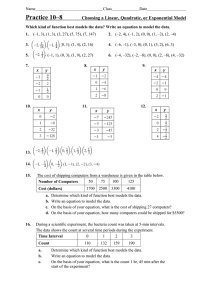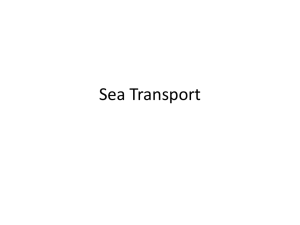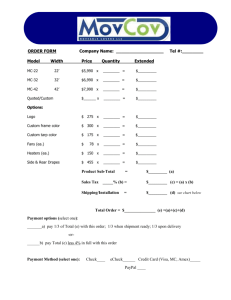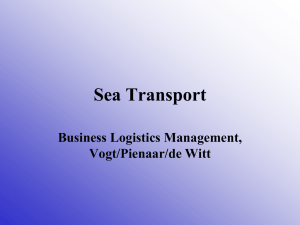INDUSTRIAL MINERAL TRANSPORTATION and MARKETING
advertisement
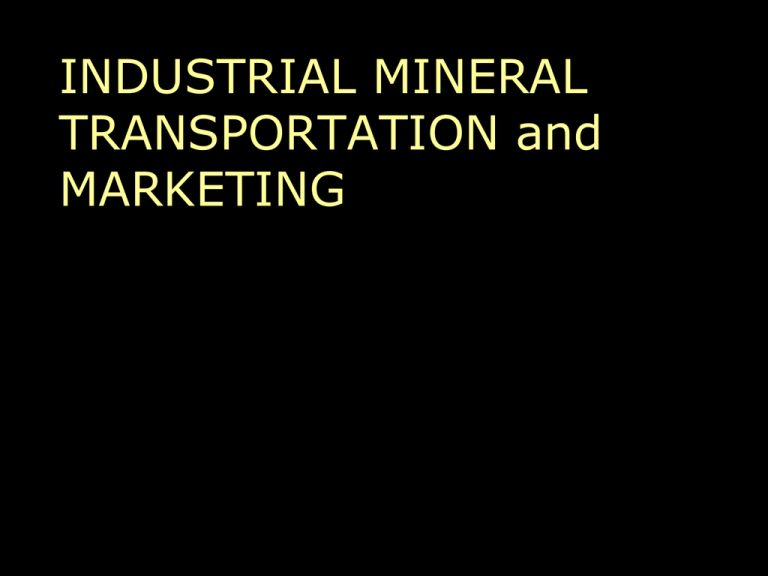
INDUSTRIAL MINERAL TRANSPORTATION and MARKETING TRANSPORTATION CONCEPTS • • • • • • • Overall transport is 21% of US economy Often >50% of delivered IM cost Bulk versus value Place value Value added Quality retention or “do no harm” Efficiency, luck, and risk Transport Often exceeds 50% of delivered cost (highest except food) Industrial Mineral As $ per short ton Mine Shipping $ $ $ End % of User del $ Construction aggregates Industrial glass/foundry sand frac sand Cement domestic imported Pumice (import) Coal Gypsum Feldspar (ground) Lime Kaolin (slurry) 4–7 7–12 15–12 2–6 6–10 25–40 6-13 13-22 40-52 27-52 39-51 65-75 40–50 26–30 10–15 19–28 5–10 40–50 35–50 30–45 8–14 8–14 9–12 10–17 10–15 40–60 15–25 20–35 48-64 34-44 19-27 29-45 15-25 80-110 50-75 50-80 15-24 22-33 42-49 30-42 57-67 47-57 26-37 45-48 GEOLOGY existence Development ⇓ TRANSPORTATION ⇓ Production profit MARKET TRANSPORTATION AS MARKETING 7 R’s of Transport Right product Right quantity Right condition Right place Right time Right customer Right cost 4 P’s of Marketing Product Place Price Promotion Service “THE MARKETING CONCEPT” • Focus all activities towards total customer management and satisfaction • Make products consumers want vs making consumers want a product • Transportation can ⇑ customer satisfaction • Industrial marketing better for IMs than consumer marketing approach • Industrial marketing focuses on customer satisfaction IM TRANSPORT COST FACTORS IM volume & processing Wet or dry; bulk or packaged Transport distance Availability, schedule & transit time Equipment & support facilities …more factors Distribution, terminal, & port facilities Support services or lack thereof Ex-Im tariffs, bonding & customs Governmental & environmental regs. Cultural or regional differences Insurance & risk-avoidance TRANSPORT RISK Truck Rail Barge Ship Lower Risk ⇓ ⇓⇓ Higher Risk TRUCK TRANSPORT • • • • Unlimited year-round movement Load & unload quickly Operate independently with small crew Flexible – Small lots & variable sizes – infrequent shipment • Very expensive; 10–25¢ per ton-mile TRUCKING 2 • • • • • • • Transports about 60% of US cargo Highest cost per ton mile Very flexible Rates fixed (common carrier) or negotiation States set common or contract carrier Common carrier serves all = highly regulated Contract carrier negotiates with each customer • separate, confidential contract rates • based on many economic and competitive factors RAIL TRANSPORT • • • • • • Slow; limited to track Inflexible Expensive, 2–4¢ per ton-mile Time, volume, distance interaction Railcars/service often unavailable Railroads often difficult to deal with Rail 2 • Subsidized or nationalized except in U.S. • Haul about 25% of freight • Railroads restrict interchange points & reciprocal switching agreements with other railroads • Today most material moves under commodity, scale, or contract rates held confidential for competitive advantage • Hauls from producer to user over a single railroad are cheaper than joint-line movement – profits are shared – some expenses duplicated Railcar service • Mingle car--100 t or less, very slow, high rates • Multiple car—1200 t or more, slow, moderate rates • Trainload--4000 t or more, cars loaded and unloaded together, fast, low rates • Unit train--contract tons per time in set number of cars, continuous turnaround service, very fast, lowest rates • Some railcar types used by IM producers are: – – – – – – hopper rapid discharge gondola covered pressure differential and special service Railroad Cost Factors • • • • • • • • • Loading time Volume moved Distance Unloading time Rail equipment Rail equipment owner Competing transport Competing rates Value of service BARGE TRANSPORT • Slow • Inflexible – needs river, canal or waterway and locks – oriented to large bulk cargoes • Limited access; grain season (Aug.–Nov.) • Inexpensive; 0.75–1¢ per ton-mile Barge 2 • Relatively unregulated rates; private contracts • Contracts negotiated via market forces • Inland waterways carry 12% of US freight for 2% of US freight billings • Inland waterway is about 23,200 km of which the lower 400 km are accessible to ocean-going vessels • Coastal seaways (Gulf Intracoastal Waterway from Texas to Florida is also important • The Rhine, and its feeder ports on the North Sea (Rotterdam, Antwerp, Amsterdam), connect via canal to the Danube and the Black Sea SHIP TRANSPORT • Slow • Needs extensive infrastructure • Very inflexible – not now geared to IM cargoes – not usually a factor inland • Seasonal (grain, iron, coal, fertilizer; E↔W) • Very inexpensive; 0.1–0.15¢ per ton mile SHIP TYPES AND SIZES TYPE CAPESIZE PANAMAX HANDYMAX HANDYSIZE GROSS DWT 100,000– 200,000+ 60,000– 80,000 40,000– 52,000 20,000– 35,000 DESCRIPTION Too big for Panama Canal; transits Cape of Good Hope or Cape Horn Maximum to transit Panama Canal; 32.2 m beam and 275m length Inexact term Inexact term SHIPPING CONTRACT RISK Through Rate Liner Trip Time or Voyage Charter Contract of Affreightment Time Charter Bare Boat Lower Risk ⇓ ⇓⇓ ⇓⇓⇓ ⇓⇓⇓⇓ Higher Risk …more risks • • • • • • Accidents Weather (time to avoid) Breakdowns Stowage errors Port problems (either end of voyage) Political problems Shipping • Tramp – – Voyage: single voyage, rates from spot market Contract of affreightment: lift specific tonnage over several voyages for a set period – Time: voyages for a specified time under direction of charterer who bears most costs except wages, victuals, and insurance as "disponent owner" – Bare boat: charterer takes vessel for specified time, staffing and operating it without restriction • • • • Liner (schedule with conference) Coastal or coaster Short sea Long sea Shipping, cont. • Underutilized in past by industrial minerals • Big 3+ = wheat, iron ore, coal, (fertilizer) • Brokers critical; history of ship helpful to limit contamination and other problems • Bulk shipping – Unregulated – Cyclical – Fixtures by negotiation Shipping, even more • Control over commodity transport greatest if shipping FOB load port and fixing a vessel – Leaves control in hands of IM producer – Ensures vessel type, contamination level, ship-owner reliability, on-time arrival – Flexibility to respond to the freight market • Charter on a delivered basis – Cost and freight, or C&F – Leaves control in the hands of the ship-owner – Causes some uncertainty and lowers flexibility Shipping Brokers • Cable, cargo, and ship brokers lessen risk – canvass the shipping market, – evaluate freight offers and services, – provide relatively unbiased opinions • Worldwide shipping market – cyclical – dominated by supply and demand – operates 24/7 • Correct choice of discharge port is critical – based on distance to customer and transport available – shortest distance is not always the cheapest TRENDS ⇑ ⇑ ⇑ ⇑ ⇑ ⇑ Deregulation & integration Marketing & transport distance Just in time delivery; mostly by truck Use of brokers, traders, trade groups Distribution centers Bulk or container terminals …more trends ⇑ ⇑ ⇑ ⇑ ⇑ Use of rail & water transport Large ships serving fewer ports Use of containers on inland waterways Importance of transport managers Internet information & commerce SUMMARY OF TRANSPORTATION TYPES TRUCK US cents/ton-mile 10-25 (high) Negotiated Rates & Regulation (→ regulated) Very high Flexibility 25 t Capacity US (Typical) Europe Varies Roadway Subsidy type Yes Containers Easy; often via Negotiations regional (Mostly dispatcher confidential) RAIL 2-4 (moderate) Negotiated (→ regulated) Moderate 100 t Varies Track Yes Hard; RR often not very responsive BARGE 0.75-1 (low) Negotiated (↓ regulated) Low 1200 t (15-40) 1500 t (4-6) Locks Yes Easier with broker, harder without SHIP 0.1 (very low) Negotiated (~ free market) Very Low 60,000 dwt 150,000 dwt Ports Yes Less hard with broker, very hard without North American Perlite A transport example • • • • • • Greek imports to East Coast of USA Trans-loading from ship to railcars Market focus reversal to West Coast Containers to Pacific Rim Also Gulf access (Mobile; Houston) Panama Canal, Cape Horn

